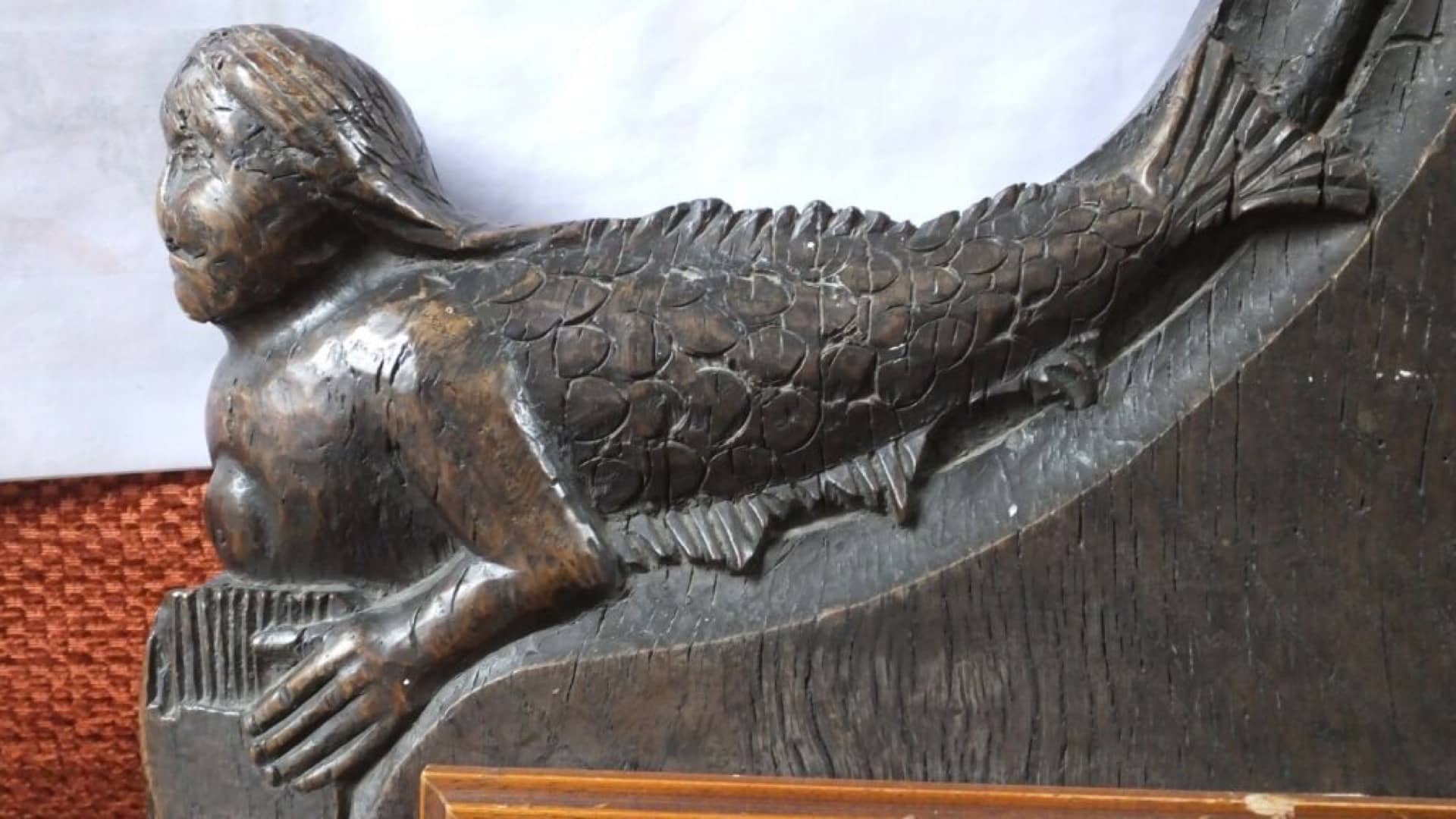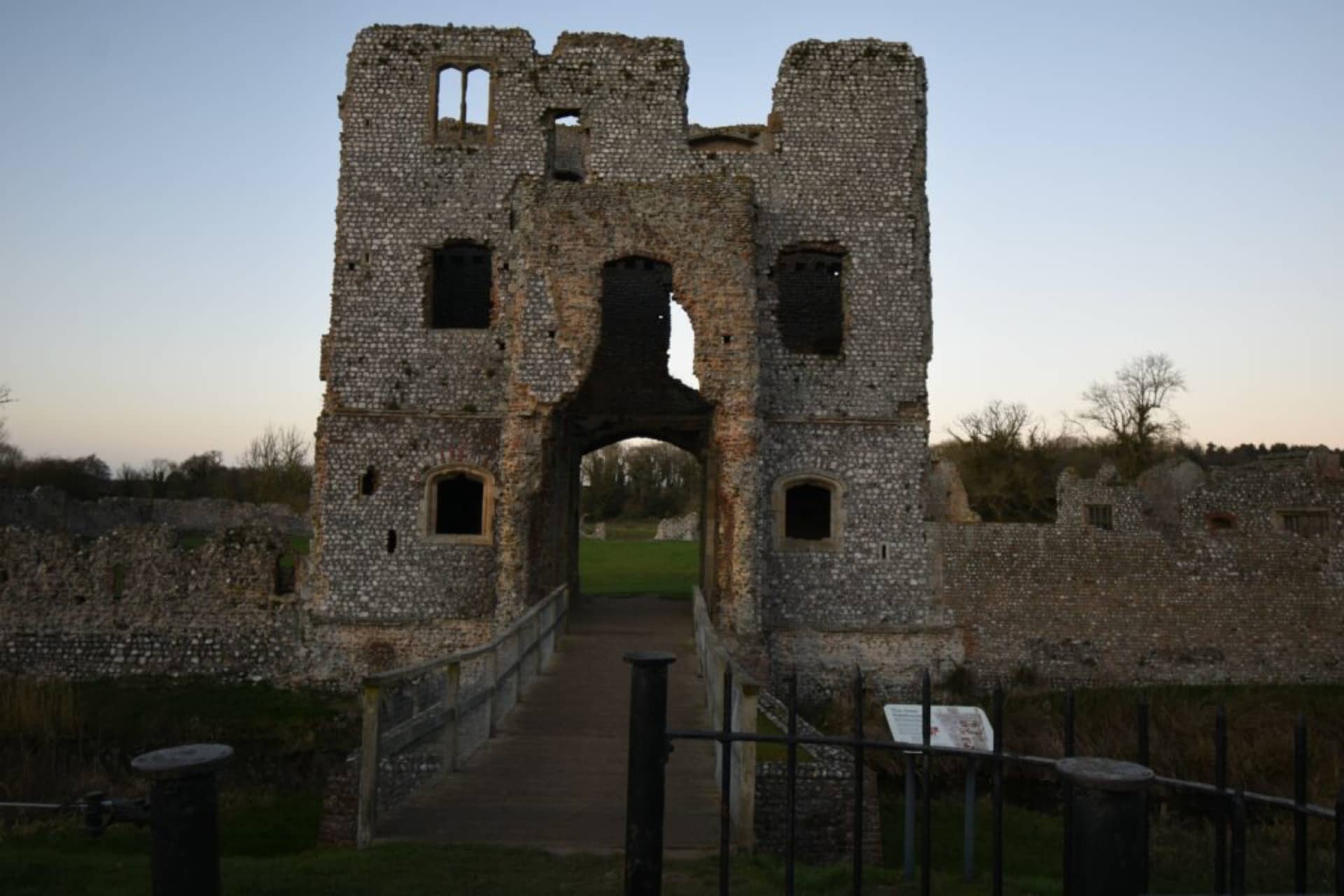
Sheringham Mermaid
On a sandbank off Sheringham, a mermaid sang to the wandering stars, forlorn and all alone. One winter night it seemed her searching voice heard an answering call. Echoing through the streets came the sweet sound of human voices raised in harmony amid cascading peals of church bells. Enchanted, she hauled herself onto the pebble beach. Her silvery fish’s tail was cumbersome in the cold air, but the singing was so beautiful she dragged her body inch by inch over the rough streets and into the church.
But these were fishing folk and mermaids are unpredictable creatures, agents of both fortune and disaster, changeable as the sea. Besides, they have no immortal soul. So the people were afraid and cast her out.
When they’d gone, she crept back into the church. And she’s there still. At All Saints in Upper Sheringham you’ll find a mermaid carved into the end of a 15th century pew. Perhaps angels took pity on the sea nymph’s lonely heart and, as wooden figureheads guide ships to harbour, they brought her safely home.
If you want to be sure of getting home safely, listen for the Yow Yows. That’s Sheringham’s term for a sudden squall, named after uncanny sounds shifting across the waves before storms strike. Some say it’s the drowned voice of an old sea captain still cursing local fishermen who let him perish. If you hear cries of eternal distress, return immediately to shore, for his warning is an omen of doom

Sheringham Park: A Vision in a Red Leather Book
Looking for Norfolk’s best winter walks? Try Sheringham Park. Rolling over nearly 1,000 acres of landscaped parkland and wooded glades it was designed by Humphry Repton to frame some of Britain’s most magnificent sea views.
Repton’s landscape proposals of 1812 are documented in one of his famous red leather books of which only 200 survive. He wrote ‘Sheringham possesses more natural beauty and local advantages than any other place I have ever seen’. Thus enchanted, Sheringham Park stands as one of the finest examples of Humphry Repton’s work and vibrant source of inspiration for landscape designers. Many of his plans were implemented by others, but Sheringham is true to Repton’s original vision; perhaps that’s why it was one of his favourites.
Paths meander through magical woodlands, farmland and down to coastal cliffs, glorious walking all year round. In late spring, shiny evergreen rhododendrons burst into gorgeous bloom, starred with abundant azaleas. Hot pink, bright orange, sassy purple, aflame with showy reckless energy. No wonder the Victorians associated them with danger as well as passion and abundance! See the clouds of vibrant colour from the tree-top tower which gives a 360º view of the park.
Four routes explore different aspects of this idyllic Victorian landscape. Time the Red Route to meet the steam train at Weybourne Station for a heritage ride back to Sheringham. Sheringham Park is brilliantly accessible for disabled visitors, with hearing loops, large print maps, Braille guides, wheelchairs and battery powered vehicles available at the Visitor Centre.

Steam Train Rover Ticket Experience
If you’re a fan of The Railway Children, roll back the years and explore the North Norfolk countryside by steam train. Chug through delightful open countryside and pretty woodland, past glorious coastal vistas and into friendly little towns where stepping onto the historic station platform feels like travelling in time. Pootle round the smart Victorian seaside resort of Sheringham, then go on to elegant Holt, a handsome Georgian market town. Or jump off at Weybourne for a bracing march down to the pebble beach where The Personal History of David Copperfield starring Dev Patel and Hugh Laurie was filmed. The North Norfolk Railway runs through the county’s most stunning scenery so get your camera ready, or settle back and enjoy the rhythm of the railway.
Enjoy an 11-mile round trip on board an historic steam engine or heritage diesel train, or make a beautiful day of it with a great value Rover ticket, valid for unlimited travel allowing you to hop on and off all day. If you feel like a walk over breezy heathland or strolling in the autumn woods, just get off the train and go for a wander. You can just catch another later, when you’re feeling peckish or fancy a pint. The heritage railway is fondly known as the ‘Poppy Line’ because 19th Century poet and theatre critic Clement Scott coined the term ‘Poppyland’ for the unspoilt coastal stretch around Sheringham where masses of scarlet poppies begin to appear from late spring.

The Great Fire of Holt
Pretty little Holt is full of fabulous independent shops, Sunday markets, restaurants and art galleries, magical for Christmas shopping, when the town sparkles with light. But once Holt was lit by a more devastating glow. It was springtime in the reign of Queen Anne. The countryside frothed with white lace flowers named after her and wild garlic scented the woods. The May Day market of 1708 was packed with people from the villages and coast selling fish, meat and eggs. Amid the good humour of a May morning, no-one saw how the fire started.
Flames raced through the market stalls and timber framed houses. Flying sparks caught the church’s thatched roof, setting the building ablaze. In only three terrible hours, the whole medieval town was reduced to smouldering ruins. Yet good can come from the darkest times…
Many homes had been squalid hovels where plague rats bred and poverty festered. Over the next 100 years, thanks to a royal brief, wealthy benefactors and skilled local craftsmen, Holt was rebuilt. Today’s elegant Georgian town rose from ashes, an elegant architectural phoenix. The back lanes and flint stone yards are Victorian, an enchanting labyrinth for imaginative gift hunters. When you stop for lunch, try Byfords on Shirehall Plain, a survivor of the Great Fire. With a 15th century cellar, this cosy warren of flint walls, flagstone floors and wood panels is now a restaurant, coffee shop, deli and delightfully posh B&B, believed to be the oldest house in Holt.

Blind Sam and the Pineapple Obelisk
Who, or what, is Blind Sam? And why was getting rid of a pineapple part of the war effort? Head to Holt where even the street furnishings have stories to tell!
The picturesque Georgian market town is brimful of independent shops, delis, restaurants and coffee shops, so you’ll need a good stroll to work up an appetite for more cake! Go for a wander round the pretty streets until you come across Obelisk Plain. Can you find Blind Sam and the Pineapple Obelisk?
The Queen Victoria Jubilee Lantern stood in the Market Place from 1887 to 1921, when it was moved to make way for the war memorial. As well as spouting water from two fountains, it was intended to light the market place at night. But, being powered by the town’s sputtering gas supply, the lamp which sporadically petered out, plunging the street back into darkness. So locals called it Blind Sam.
And what about the fruity tale? Look for an obelisk topped with a pineapple. It was originally one of two gateposts from Melton Constable Park, pineapples being a traditional symbol of welcome. The other was given to the town of Dereham in 1751. Each was used as a milestone, with distances carved in the pillar – which could have been very useful info for an invading army! So at the outbreak of WW2, the Dereham obelisk was (somewhat dramatically) thrown down a well. Holt kept calm and carried on, simply whitewashing the mileage to confound the enemy. Bravo!
Build your own itinerary
If you fancy creating your own itinerary for a day trip to Norfolk or a longer visit, it couldn’t be simpler. Just go to Search Activities and select from our wide range of free and paid-for experiences, saving any that capture your imagination with the click of a button.
Once you’ve finished, you’ll find all the information stored in My Favourite, where you can drag and drop activities to create your own day-by-day itinerary! You can download this to a calendar and even share it with friends.
